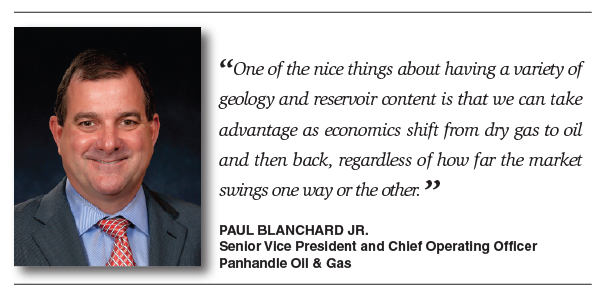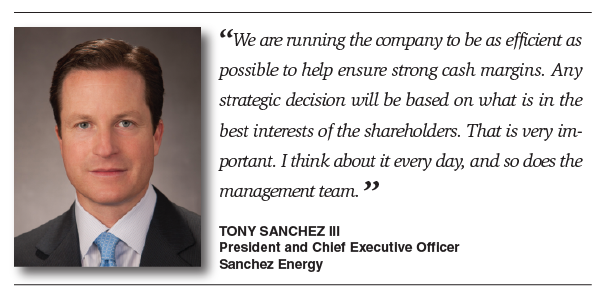
Unique Business Approaches Help Operators Find Answers To Achieving Upstream Success
By Gregory DL Morris - Special Correspondent
Given the logistics and costs of developing unconventional resource plays, many independents have expanded their operational scales and corporate reaches to capitalize on opportunity sets in these plays. However, there is a cadre of independents with a tight focus on certain plays, a keen eye on their balance sheets, and an unabashed ambition that Dad Joiner would applaud.
Some, such as Panhandle Oil & Gas, have a legacy stretching back almost a century. Others, such as Sanchez Energy, are only a few years old. The two have very different strategies, yet both are concentrating on specific onshore basins, using horizontal drilling and advanced completion techniques.
While Panhandle and Sanchez Energy keep their feet dry, Saratoga Resources works near the Louisiana shoreline, drilling from barges in shallow state waters.
From semi-integrated companies with their own rig fleets and midstream facilities making headlines in unconventional reservoirs to small exploration firms flying under the radar in conventional plays, there is no such thing as a “typical” independent.
True To Its Roots
Panhandle Oil & Gas was founded in Texas County in the Oklahoma Panhandle as a co-op (Panhandle Cooperative Royalty Company) in 1926, and has never strayed from its roots. Its oil and gas holdings are still concentrated in Oklahoma, and although no longer a co-op, it does not operate any projects.
Yet, the nature of the company’s assets has changed dramatically as its focus has shifted to unconventional resource projects on its acreage in the Woodford Shale, the Anadarko Cana Woodford Shale, the horizontal Anadarko Basin Granite Wash, the Arkansas Fayetteville Shale, and several other oily and wet gas plays in western Oklahoma, reflects Michael Coffman, president and chief executive officer.
“Panhandle’s activity in these projects is expected to continue for many years with more than 4,000 potential drilling locations,” he says, noting that the company owns 255,857 fee mineral acres as well as a working and/or royalty interest in more than 5,600 wells.
As of September, Panhandle had 151.8 billion cubic feet equivalent of proved reserves.
Panhandle operated as a co-op until 1979, when it became a C corporation after merging into Panhandle Royalty Company and registering its shares with the U.S. Securities & Exchange Commission. “There was no public offering at that time. We issued shares to existing co-op members only,” recalls Coffman. “And we have never had a secondary offering.”
In 2007, the company’s name was changed to Panhandle Oil & Gas Inc. That change was made to end confusion as to the nature of the company’s operations, Coffman says, commenting, “Panhandle has never been a royalty trust and is not strictly a royalty company. Panhandle pays dividends on its common shares.”
There have been splits in the stock, but Panhandle’s 8.4 million shares still are held by a relatively small cohort of about 4,000. “That number includes investors from large mutual funds to great-grandchildren of our original co-op owners,” Coffman observes.
He laughs when asked about the potential for a secondary offering. “We get approached about that all the time. But we have been able to generate sufficient cash flow from operations, helped by some bank debt when prudent, so we don’t need a secondary offering. We keep a very clean balance sheet, so we are able to borrow at very attractive rates, and we pay down debt as quickly as we can,” Coffman states.
That conservative nature, he postulates, is a legacy of the co-op days when every owners’ capital was at stake. Coffman acknowledges there have been times when telling the Panhandle story using terms such as “living within our means” has sounded somewhat quaint when compared with some of the fast-growth models espoused by other players.
Nonoperator Model
A key differentiator of its strategy is that Panhandle does not operate any of its properties. Instead, exploration and development activity on its properties is conducted in partnership with primarily large independents acting as operator, points out Paul Blanchard Jr., senior vice president and chief operating officer.
When times turn tight, “having ‘no-borrow’ periods sounds like a novel idea,” notes Blanchard. “We are close again to having essentially no debt.”
That situation is reminiscent of a line from A Chorus Line, when a young performer remembers being complimented for being “different,” and laments, “Different is nice, but different isn’t pretty. Pretty is what it’s about.”
Coffman recalls, “It has been a struggle in the past to get the potential investor base and the analyst community to understand what we are doing. When we started, no one else was using a nonoperating model on fee acreage. For years, that approach never got people giddy. The analysts liked our clean balance sheet, but always worried that there was ‘no catalyst in the next six months.’ I guess they usually were right; we always have been just ‘steady Eddys.’
“These days, however, people are starting to think our qualities are good things,” Coffman adds. “The sales job has gotten a lot easier.”
Not being preoccupied with financial engineering allows Panhandle’s management to focus all the more fully on acquiring mineral rights and assessing which wells to take working interests in, offers Blanchard. Panhandle is a nonoperator, but that hardly means it is a passive casher of royalty checks.
“Over the past two years, we spent roughly $28 million acquiring additional mineral rights and leaseholds held by production,” he points out. “That is primarily in the Fayetteville, where there has been a lot of drilling. That is in contrast to the more traditional independent producer, which would lease rights and then drill. Often, we will take a working interest in the well, but not always.”
Coffman says the nonoperating model evolved from the co-op era. He has been with the company for more than 20 years, and became president in 2006. “We bought fee acreage in the Fayetteville in the 1990s, and when I took over, I wondered how to grow. In the Fayetteville, Woodford and other plays, we grew our working interests, in some cases, up to the limit–5 to 10 percent, and in one case, 42 percent,” he relates. “We have to borrow some money to pay our share of the development costs and get things going, but that approach has taken off, and now we get a bigger piece of the pie.”
Blanchard says having a clean balance sheet, living within means, and selecting working interest investments carefully proved their value a few years ago, when natural gas prices collapsed. “We had good economics, even then,” he says, “even in dry gas. We always sought to have a good diversity of gas and oil. There is security in having a variety of geology and reservoir content.”
He adds, “One of the nice things about having a variety of geology and reservoir content is that we can take advantage as economics shift from dry gas to oil and then back, regardless of how far the market swings one way or the other.”
Reservoir Drilling
Panhandle executives say that when development approaches that were successful in resource plays started to be applied to conventional reservoir drilling, it really lent itself to their acres in western Oklahoma and the Texas Panhandle.
That was new territory for some shale players, but for a company that dates to 1926, it was home territory. “We knew zones such as the Cleveland, the Marmaton, the Granite Wash and the Hogshooter were there,” says Blanchard. “They had been penetrated many times over the years, and were judged to be marginal to uneconomical as traditional vertical developments. But they all respond very well to horizontal drilling and new stimulation techniques.”
He adds, “We have gone from exploration and discovery to production very quickly in conventional reservoirs, in part, because they are all so mapable.”
On average, he says, Panhandle owns about 5 percent of the mineral rights in a unit, which does not give the company much sway in producers’ decisions on where or when to drill. “We do have to wait until a producer comes in, but in general, we participate to some degree in about three quarters of the wells on our acreage,” Blanchard attests. “We take the other quarter to the market and start a bidding process in order to lease for the highest bonus and royalty. That is a unique aspect of our operation. Getting the royalty and the working interest really boosts the economics for us. The focus of my group is to determine where and when to participate, and by how much.”
Given Panhandle’s holdings, that is a full time job. “We have widely diverse acres,” Coffman says. “We don’t like to get too concentrated. As a result, we get several hundred well proposals every year. There are a lot of opportunities and a lot of choices.”
That goes for operators as well as wells, he notes, saying Panhandle works with many producers, but some more often than others. Frequent collaborators include Southwestern Energy, Devon Energy, Continental Resources–especially in the Anadarko Woodford, Cana, and the South Central Oklahoma Oil Province–Cimarex Energy Co., Apache Corp., Chesapeake Energy, EOG Resources, and SM Energy.
While stressing that “there is plenty to do at home,” Coffman adds, “We do also participate in Bakken and Permian wells, and we look at acquisitions outside of the Mid-Continent. We are interested in a bigger foothold. We also have a good holding in New Mexico.”
Not being operators does not mean Panhandle will settle for any old land in a play. “We are most interested in core acres,” says Blanchard. “We also are interested in first tier acres at a good price, but not much beyond that. Once you get into second tier acres in any play, the long-term economic viability is often difficult.”
Bayou Bonanza
Saratoga Resources is an independent exploration and production company with offices in Houston, Texas and Covington, La. Principal holdings cover 52,033 acres–most held by production–located in the transitional coastline and protected in-bay environments on parish and state leases in South Louisiana and on the shallow Gulf of Mexico Shelf. Most of the company’s large drilling inventory has multiple pay objectives ranging from as shallow as 1,000 feet to ultradeep prospects below 20,000 feet in water depths ranging from less than 10 feet to about 80 feet.
“We keep 100 percent working interests in all our wells,” declares Saratoga President Andrew Clifford. “We are exploring some partnerships, but those would be with firms around our own size. We try to stay away from the really large players that can ‘AFE’ you to death. When things get tight, we can scale back and wait for better conditions.”
Indeed, one of the potential partner firms with which Saratoga has been talking has had its hands tied by other alliances, Clifford relates. “What its bigger partners want to drill is what gets drilled, and that takes all (the smaller company’s) cash. It can’t do anything on its own wells.”
The arena in which Saratoga seeks large partners is financial. “We have been working with some of the big investment banks and private-equity firms,” Clifford says.
The reason Saratoga is seeking the top tier of investors, he confides, is senior management’s goal to build the company into a billion-dollar firm. “We are not a build-and-flip management team,” he emphasizes.
The growth goal is not for the sake of size alone. “We want to get to a lower cost of capital,” explains Clifford.
To get there, he says Saratoga would be interested in acquiring another company of the same size or smaller–one active in the shallow water, transition and onshore zones where Saratoga works. He adds that he is keen on the Permian Basin as well, but not so much on the Eagle Ford or Bakken.
An acquisition would be a solid and rapid way for the company to increase reserves and production, Clifford says. “It also would get our bonds a better rating,” he remarks. “I am confident we could find a like-minded firm, perhaps a private company seeking access to the public markets. Someone active in the Permian Basin could be an example. We would be Saratoga Gulf Coast and it would be Saratoga Permian, and both operations could build bigger and better by working together. We are looking for a one plus one equals three situation.”
There is another driving force, Clifford acknowledges. “Everyone active in the Gulf Coast needs capital. We are a little undercapitalized, but we can boost that. Any acquisition would have to be accretive. We don’t want to turn the balance sheet upside down. The goal of a transaction would be to lower the cost of debt and equity. We are thinking big.”
All the big thoughts come from Clifford’s background with Exxon, BHP Billiton and Chevron. “One of the great things about the industry today is that companies our size have access to the same technology as do the big guys,” he affirms. “We don’t need to have those tools and talent in-house; we can work with top outside firms.”
Crashing The Party
For all the attributes and advantages that size can confer, Clifford notes an essential operational philosophy that differs among the majors and big and small independents. “The big guys leave a lot of meat on the bone,” he surmises. “It is insignificant for them to develop some of the fields we develop. I can assure you those properties are important to us. We can do it faster and cheaper, and it means a lot more to us than it does to them.”
The ultrashallow water where Saratoga makes its living has the advantage to a small company of being literally and figuratively overlooked. “I gave a paper recently at a Gulf Coast geological sciences conference,” Clifford relates. “I give a similar talk all over. The transition zone is neither onshore nor off. It’s where a lot of historical plays got their start, but these fields never got 3-D seismic until the 1990s. By that time, the majors and big independents were leaving the domestic market already, at least onshore and near shore. They were moving to the deep water and international.”
Even if Saratoga is not seeking partnerships with larger companies, it still is running with the big dogs. “Swift Energy is one of the few midsized independents that has been successful in the transition zone,” Clifford says. “Now we are seeing Energy XXI and Apache doing wide-azimuth surveys. There have been a handful of great successes. Gulfport Energy Corp. gets a lot of attention for its Utica activity, but it makes 90 percent of its money in the Gulf Coast transition zone.”
One of the exciting features of the zones where Saratoga drills, says Clifford, is their stacked pays. “We don’t have any salt domes,” he says. “We prefer more prospective plays. Our Grand Bay acreage has 65 stacked reservoirs; there is virtually limitless prospectivity all the way down.”
Typically, Saratoga drills from barges in as little as six feet of water, which costs the same as drilling on dry land, Clifford states. “We do have to dredge to keep channels open to our sites, but that is no greater expense than having to build roads, he says. “We like the accessibility, we love Louisiana Light Sweet pricing, and we love the lack of competition.”
He also likes the availability, Clifford adds. “We are on state land, and only about one in 10 acres is leased,” says Clifford. “Auctions are held monthly, not annually like the federal offshore leases. We picked up new reserves in our Little Bay development for $350 an acre, and that was considered a big bid. The stacked-pay conventional reservoirs are as repeatable as a shale play. That keep costs low and keeps us producing. We can make money at $3 an Mcf.”
That is good, he adds, because to sustain expansion and possible acquisitions, Saratoga needs more production and cash flow. And while the company’s production has proven to be highly resilient following hurricanes, any major storm does take wells out of service for about 30 days from wind down to restart.
Clifford also acknowledges that Saratoga “dropped the ball on gas lift” for a few wells, but that is being rectified, he asserts. “But even as production is hampered temporarily, we have plenty of other recompletion options,” he says.
Saratoga’s goal for 2014 is to have one rig drilling and one rig doing workover and recompletions.
The Terrific Twos
Babies go through the terrible twos, but for Sanchez Energy, an independent, publicly traded company producing in the Eagle Ford Shale, the company’s second anniversary in December was a celebration of the “terrific twos.”
Sanchez Energy reported fourth quarter 2013 production of 1.73 million barrels of oil equivalent (18,810 boe/d), an increase of 60 percent over third quarter 2013 and 905 percent more than the same period a year ago. Production consisted of 1.27 million barrels of oil, 224,000 barrels of natural gas liquids, and 1.45 Bcf of natural gas. The company has 25 gross wells in various stages of drilling and completion.
The company also provided a 2014 exit-rate production guidance range of 22,000 to 26,000 boe/d, and projected a more than 100 percent increase in calendar 2014 production over 2013 production.
President and CEO Tony Sanchez III says the company’s 2014 capital budget has been pegged at $650 million-$700 million. “That will allow us to drill approximately 70 wells and continue to add bolt-on acreage and build out our gathering infrastructure. We are doing a lot of infill drilling and down-spacing of our high-quality locations,” he says.
Sanchez Energy also is dedicating a portion of its capex to delineation. “We will be doing some step-out drilling, but by steps, not by big leaps,” Sanchez says, although the firm has not yet disclosed the details of its 2014 drilling program.
When Sanchez Energy was carved out of its parent company, all the firm’s unconventional development went with it, including a tiny Haynesville Shale position that is not active because of low natural gas prices, Sanchez says, as well as some acreage in Montana that was prospective for the Bakken Shale. However, he says, that never came to fruition and those leases were not renewed.
“One hundred percent of our production and about 90 percent of our capital is going into the Eagle Ford,” Sanchez says.
Nevertheless, the public company has entered the Tuscaloosa Marine Shale (TMS) in a joint venture with one of its privately held entities, Sanchez Resources. Sanchez Energy acquired 40,000 undeveloped net acres in the core of the TMS.
“With a significant portion of the acquired acreage held by production and plenty of term on the remaining acreage, we plan to participate in several nonoperated wells in the area before commencing our operated TMS drilling program,” Sanchez outlines. “As well costs trend down and well performance continues to improve, we see significant upside potential from this strategic diversification while maintaining our focus on our Eagle Ford operations.”
Early in October, Sanchez Energy completed its Wycross acquisition in the Eagle Ford. Including the $11 million deposit, total consideration for the acquisition was $230 million, which includes the $220 million purchase price and $10 million in closing adjustments. Sanchez says the transaction was funded from the net proceeds from selling 11 million shares of common stock and $200 million of 7.75 percent senior notes, due in 2021.
Maximizing Production
“The Wycross acquisition added another high-return, oil-weighted asset to our Eagle Ford operations with approximately 11 million barrels of oil equivalent reserves and 2,000 barrels a day of production,” Sanchez reports. “Wells on this asset were drilled on 80-plus acre spacing from single-well pads. We plan to develop this area on 40-acre spacing, and move to pad drilling to further reduce costs and provide additional upside potential.
“Our operating strategy is to maximize production and reserves,” he continues. “We made several acquisitions in 2013, which really was our focus for the first part of the year. With the Wycross and Hess Corp. transactions completed, we have shifted our focus to more development and maximizing production. We now have a very strong, multiyear inventory of drilling locations.”
Sanchez is circumspect about a long-term vision for the company. “Day to day, we are running the company to be as efficient as possible to help ensure strong cash margins,” he imparts. “Any strategic decision will be based on what is in the best interests of the shareholders. That is very important. I think about it every day, and so does the management team.”
Sanchez states frankly that he does not know what the long-term status of the public company will be–a growing stand-alone producer or part of some larger operation. “What I do know is that driving margins and growth the highest possible is what creates value for shareholders,” he says.
Management is the single largest segment of that ownership group, Sanchez details, along with his family, which still controls multiple privately held companies. “We also have a fairly substantial institutional base behind us,” he adds.
That includes Lord Abbett, Times Square, Millennium, and other private-equity investors, as well as several long-term private investors.
One advantage that Sanchez Energy has as an oil producer in the Eagle Ford is that it has not been subject to the transportation capacity concerns that have plagued natural gas and NGL producers. “We can get our oil to market by truck or pipeline,” Sanchez observes. “When there is a pipe, or we can lay line, we do. That gains us $2-$4 a barrel in net back over trucks, but there have not been the same bottlenecks for oil that there have been for gas and NGLs.”
Sanchez Energy sells its oil at the wellhead, primarily to marketers. “We have had some discussions directly with refiners, but we don’t do much business that way,” Sanchez says.
That follows the company mantra of focus and efficiency, he reflects. Similarly, he mentions, Sanchez Energy does an occasional joint development with adjacent producers or the odd lease swap, but it is not a significant part of daily operations.
For other great articles about exploration, drilling, completions and production, subscribe to The American Oil & Gas Reporter and bookmark www.aogr.com.










